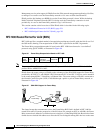
Overview of IBM Networking
SNA FRAS
BC-225
Cisco IOS Bridging and IBM Networking Configuration Guide
78-11737-02
permanent virtual circuit, Cisco supports SAP multiplexing, which allows you to configure unique LLC2
SAPs for each downstream SNA device so that they can share a single permanent virtual circuit to an
FEP.
The Cisco IOS software is responsible for terminating the local data-link control frames (such as SDLC
and Token Ring frames) and for modifying the data-link control frames to 802.2 compliant LLC frames.
The LLC provides a reliable connection-oriented link layer transport required by SNA. (For example,
802.2 LLC is used to provide link layer acknowledgment, sequencing, and flow control.)
The Cisco IOS software encapsulates these 802.2 LLC frames according to the RFC 1490 format for
SNA traffic. The frames are then forwarded to the SNA host on a Frame Relay PVC. In the reverse
direction, the software is responsible for de-encapsulating the data from the Frame Relay PVC, and for
generating and sending the appropriate local data-link control frames to the downstream devices.
RFC 1490 Bridged Format for LLC2 (BAN)
BAN provides functionality similar to BNN except that it uses a bridged frame format, as illustrated in
Figure 100.
Figure 100 RFC 1490 Bridged Frame Format
Because it includes the MAC header information in every frame, BAN supports multiple SNA devices
sharing a single permanent virtual circuit without requiring SAP multiplexing. BAN also supports load
balancing across duplicate data-link connection identifiers to the same or different front-end processors
at the data center to enhance overall availability. BAN works for devices attached by either Token Ring
or Ethernet.
5
1912
Q.922 address
OUI 0x80-C2 (bridged)
PID 0x00-09
Destination/source MAC (12 bytes)
Control
SNA data
PCS
pad 0x00 Frame control
DSAP SSAP
NLPID SNAP 0x80 OUI 00x0
Control 0x03 pad 0x00


















